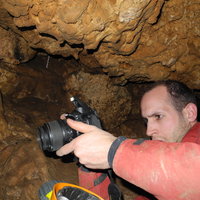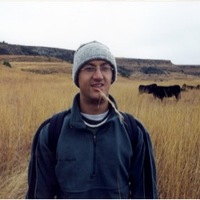
Nicolas LATEUR
Related Authors
Patricia Valensi
Muséum National d'Histoire Naturelle
Jarod Hutson
Leibniz-Zentrum für Archäologie
Sophie Grégoire
Université de Perpignan-Via Domitia
Ivana Fiore
Sapienza University of Roma
Paul Fernandes
Paleotime
Kévin Di Modica
Centre de recherches de la grotte Scladina
Antonio Tagliacozzo
Ministero della cultura
Jean-Paul Raynal
Université Bordeaux








Uploads
Papers by Nicolas LATEUR
season, mainly summer. The intensive exploitation of the faunal resources is typical of a residential campsite, and the selective seasonal hunting strategy of medium and large ungulates, centred on prime adults, indicates different Neanderthal subsistence patterns to the upper levels of the sequence. Here, our results document the chronological changes in occupation patterns in one of the reference sites in southeastern
France and address questions related to cultural choices and environmental constraints.
Les opérations de diagnostic menées en amont par l’Inrap avaient notamment mis en évidence une structure avec des vestiges attribués au Néolithique ancien ainsi que, dans une fosse, la présence d’os d’aurochs (Bos primigenius) dont la datation (Beta-468493 : 10200 ± 30 BP, soit 10100-9816 cal BC) (Convertini et al., 2017) situait celui-ci dans un horizon tardiglaciaire. Suite à la prescription de Bourbouissou, les fouilles menées par Paleotime ont ainsi documenté huit creusements de forme circulaire correspondant à cet horizon épipaléolithique et contenantdes vestiges de faune et des pièces lithiques confirmant cette attribution.
(AIGUÈZE, GARD – FRANCE). Along with faunal remains, many traces give evidence for the frequentation of the cave by both wild and domestic fauna. Points cave was also used as a sheepfold during recent historical times. Caprids scats were found in the half-ligh part of the cave. Three cave hyena scats highlight its presence on the site while no bones or teeth from this species have been identified so far. Historical modifications of the cave floors related to the exploitation of its sediments did not allow observing neither footprints nor hibernation beds of cave bear. Nonetheless, claw marks of badger and small mustelids were identified on the walls. The most abundant bioglyphes are the polished parts of the walls resulting from repeated rubbing by cave bears, and perhaps other wild species such as ibex or even domestic animals near the entrance of the cave. All these traces bring interesting chronological data.
hunter-gatherers. In the meantime, the presence of carnivores is noticeable by their
remains (teeth, bones, coprolites) and the marks they left on the bone assemblage.
Thus la grotte aux Points appears to be a key-site to grasp palaeolithic foraging
behaviors in the Ardeche river canyon and to approach Hominin-Carnivore interactions
during the Late Pleistocene.
However, reindeer-dominated assemblages have largely been reported from regions of northern Germany and south-western
France, with few examples noted in south-eastern France,where faunal assemblages yield most of the time a variety of other large
ungulates such as red deer, horse and diverse bovids. Here, we present multi-strand (bio- and eco-) archaeological datasets from
the site of Abri du Maras (level 4.1), situated at the mouth of the Ardèche and Rhône rivers, a new example of a reindeerdominated
Neanderthal site in south-eastern France. Dated to the beginning of the MIS 3, the zooarchaeological assemblage is
dominated by reindeer (88% of the NISP, representing 16 individuals) but also includes horse, bison, giant deer (Megaloceros
giganteus), red deer, ibex and lagomorphs. The combination of zooarchaeological, cementochronological and tooth microwear analyses evidence a single species-dominated spectrum, with catastrophic mortality and repeated autumnal deaths. This integrated approach provides an extensive picture of human subsistence behaviour, ointing to short-term hunting episodes of reindeer herds in an exceptional context of a quasi-exclusive Neanderthal accumulation. The high number of individuals and elective butchery may correspond with a cooperative and planned mass hunting strategy. The multidisciplinary approach undertaken here also incorporating paleontological, charcoal, ecological and isotopic analyses places the archaeological nd zooarchaeological data within a broader regional palaeoenvironmental framework, providing valuable landscape-contextual information. The zooarchaeological data suggest a subsistence behaviour different from other Neanderthal reindeer-dominated assemblages often connected with specialised butchery or hunting sites.
Talks by Nicolas LATEUR
season, mainly summer. The intensive exploitation of the faunal resources is typical of a residential campsite, and the selective seasonal hunting strategy of medium and large ungulates, centred on prime adults, indicates different Neanderthal subsistence patterns to the upper levels of the sequence. Here, our results document the chronological changes in occupation patterns in one of the reference sites in southeastern
France and address questions related to cultural choices and environmental constraints.
Les opérations de diagnostic menées en amont par l’Inrap avaient notamment mis en évidence une structure avec des vestiges attribués au Néolithique ancien ainsi que, dans une fosse, la présence d’os d’aurochs (Bos primigenius) dont la datation (Beta-468493 : 10200 ± 30 BP, soit 10100-9816 cal BC) (Convertini et al., 2017) situait celui-ci dans un horizon tardiglaciaire. Suite à la prescription de Bourbouissou, les fouilles menées par Paleotime ont ainsi documenté huit creusements de forme circulaire correspondant à cet horizon épipaléolithique et contenantdes vestiges de faune et des pièces lithiques confirmant cette attribution.
(AIGUÈZE, GARD – FRANCE). Along with faunal remains, many traces give evidence for the frequentation of the cave by both wild and domestic fauna. Points cave was also used as a sheepfold during recent historical times. Caprids scats were found in the half-ligh part of the cave. Three cave hyena scats highlight its presence on the site while no bones or teeth from this species have been identified so far. Historical modifications of the cave floors related to the exploitation of its sediments did not allow observing neither footprints nor hibernation beds of cave bear. Nonetheless, claw marks of badger and small mustelids were identified on the walls. The most abundant bioglyphes are the polished parts of the walls resulting from repeated rubbing by cave bears, and perhaps other wild species such as ibex or even domestic animals near the entrance of the cave. All these traces bring interesting chronological data.
hunter-gatherers. In the meantime, the presence of carnivores is noticeable by their
remains (teeth, bones, coprolites) and the marks they left on the bone assemblage.
Thus la grotte aux Points appears to be a key-site to grasp palaeolithic foraging
behaviors in the Ardeche river canyon and to approach Hominin-Carnivore interactions
during the Late Pleistocene.
However, reindeer-dominated assemblages have largely been reported from regions of northern Germany and south-western
France, with few examples noted in south-eastern France,where faunal assemblages yield most of the time a variety of other large
ungulates such as red deer, horse and diverse bovids. Here, we present multi-strand (bio- and eco-) archaeological datasets from
the site of Abri du Maras (level 4.1), situated at the mouth of the Ardèche and Rhône rivers, a new example of a reindeerdominated
Neanderthal site in south-eastern France. Dated to the beginning of the MIS 3, the zooarchaeological assemblage is
dominated by reindeer (88% of the NISP, representing 16 individuals) but also includes horse, bison, giant deer (Megaloceros
giganteus), red deer, ibex and lagomorphs. The combination of zooarchaeological, cementochronological and tooth microwear analyses evidence a single species-dominated spectrum, with catastrophic mortality and repeated autumnal deaths. This integrated approach provides an extensive picture of human subsistence behaviour, ointing to short-term hunting episodes of reindeer herds in an exceptional context of a quasi-exclusive Neanderthal accumulation. The high number of individuals and elective butchery may correspond with a cooperative and planned mass hunting strategy. The multidisciplinary approach undertaken here also incorporating paleontological, charcoal, ecological and isotopic analyses places the archaeological nd zooarchaeological data within a broader regional palaeoenvironmental framework, providing valuable landscape-contextual information. The zooarchaeological data suggest a subsistence behaviour different from other Neanderthal reindeer-dominated assemblages often connected with specialised butchery or hunting sites.